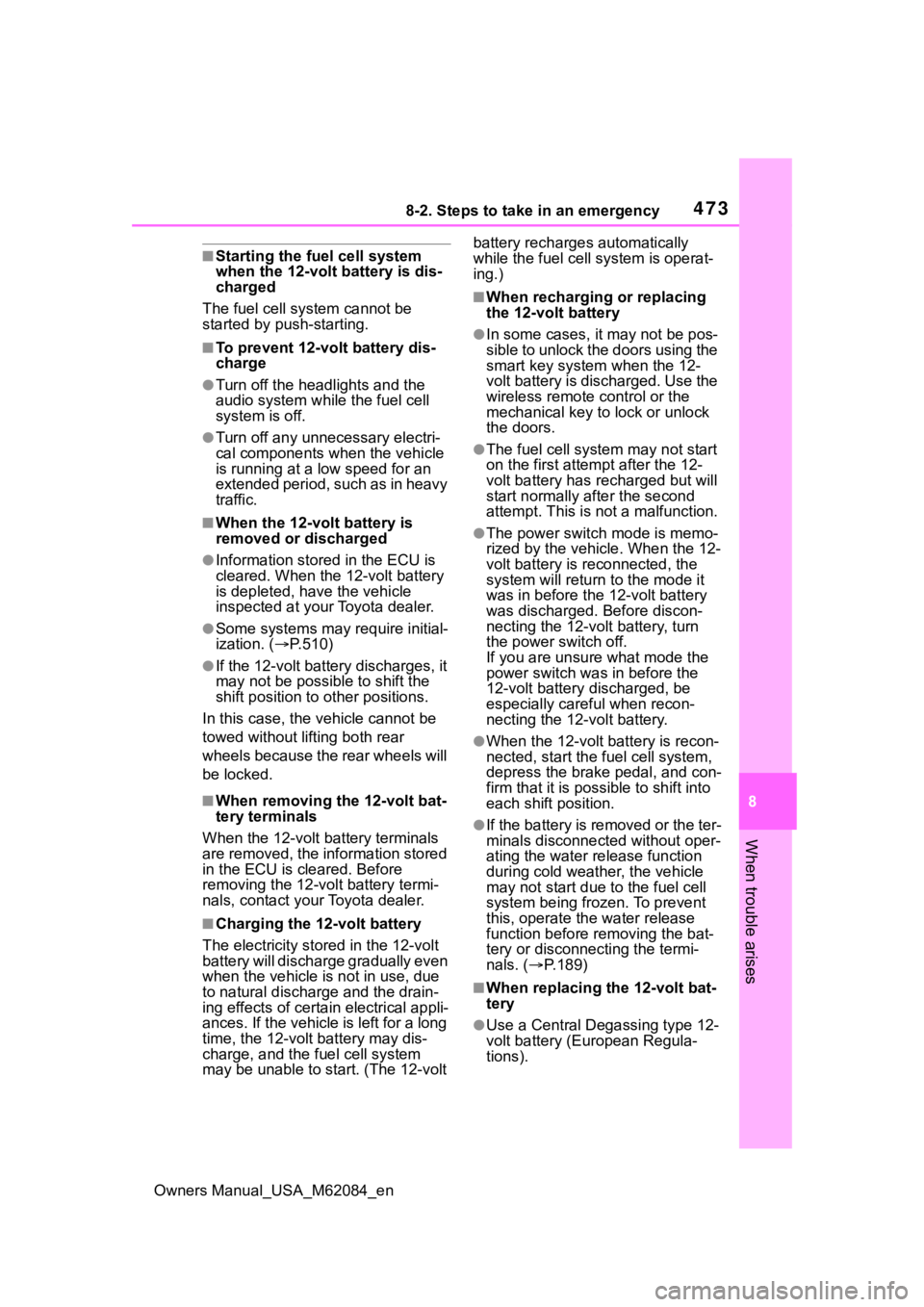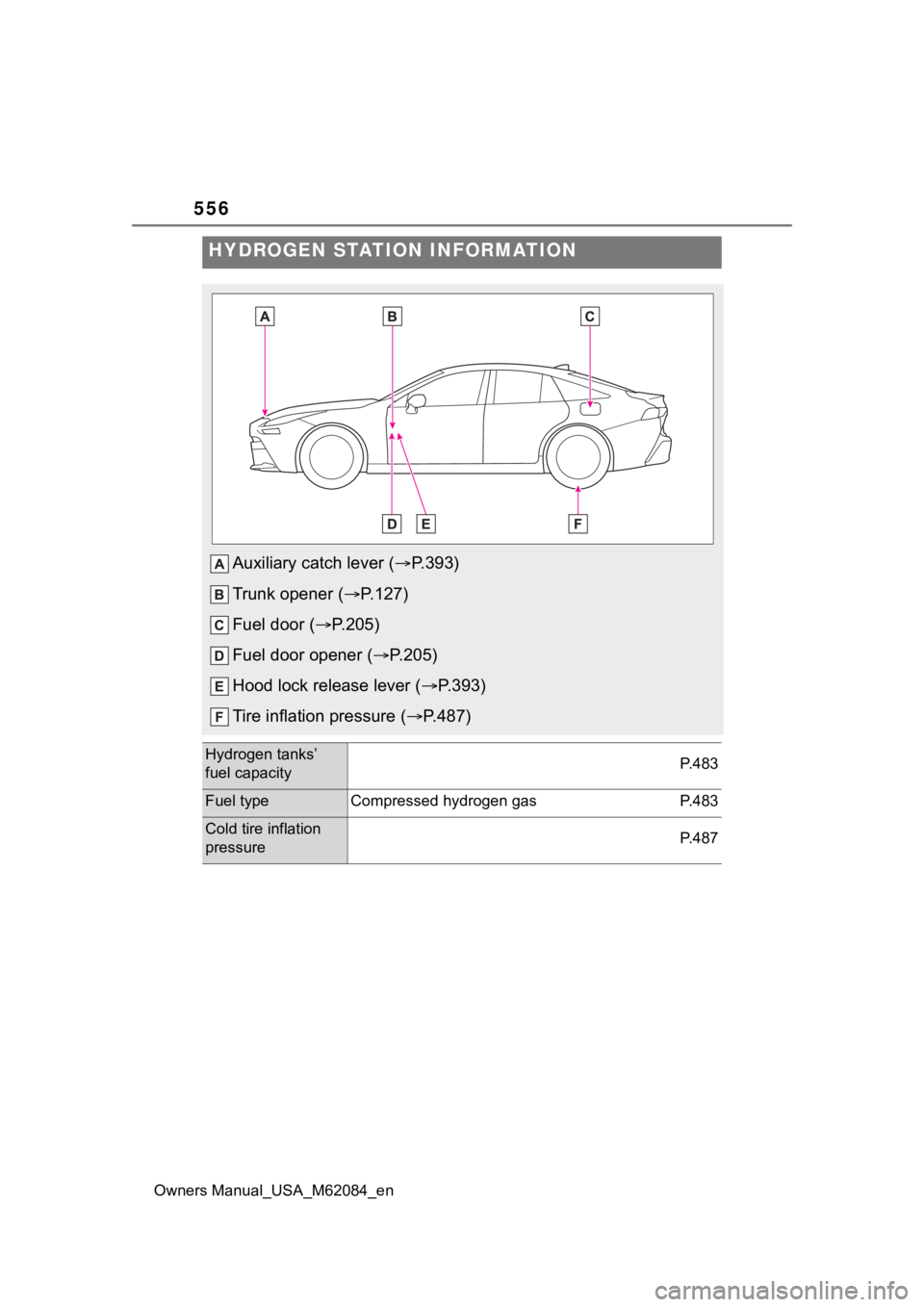2022 TOYOTA MIRAI gas type
[x] Cancel search: gas typePage 203 of 556

2035-4. Refueling
Owners Manual_USA_M62084_en
5
Driving
5-4.Refueling
Close the all the doors and
windows.
Set the parking brake.
Shift the shift position to P.
Turn the power switch off.
Turn off the headlights.
■Fuel types
P.483
■Notes on fueling
●Fueling will not be possible if the
pressure inside the vehicle’s
hydrogen tanks is higher than the
supply pressure of the hydrogen
station. If the hydrogen tanks are
more than half full, the vehicle will
be unable to fuel at a H35 dis-
penser. A hydrogen station with a
H70 dispenser (supply pressure of
10150 psi) [70 MPa, 714 kgf/cm
2,
700 bar] is necessary to com-
pletely fill hydrogen tanks.
●If the fueling cannot be completed
due to trouble with the station
equipment, call the number indi-
cated on the equipment.
Opening the fuel door
Fuel with compressed
hydrogen gas only at hydro-
gen stations.
Fuel at hydrogen stations
conforming with the Society
of Automotive Engineers
(SAE) J2601 fueling proto-
col or laws that may super-
sede such SAE protocols.
Refer to the Mirai Station
Finder Application in Con-
nected services,
https://www.toyota.com/
connected-services/ (for
U.S. owners) or
https://www.toyota.ca/
toyota/en/about/
connected-services (for
Canadian owners), or call 1-
800-331-4331 (for U.S.
owners) or 1-888-869-6828
(for Canadian owners).
Observe any notices or
instructions shown at hydro-
gen stations.
The filling time and amount
of fuel may depend on out-
side temperature and the
equipment at that hydrogen
station.
Vehicles with expired hydro-
gen tanks must not be used.
Check P.81 to learn how
and when to check the expi-
ration. Consult your Toyota
dealer.
Before filling
WARNING
■When filling
Observe the following precautions
while fueling the vehicle. Failure
to do so may result in death or
serious injury.
Page 384 of 556

3847-1. Maintenance and care
Owners Manual_USA_M62084_en
Remove dirt and dust using a
vacuum cleaner. Wipe dirty
surfaces with a cloth damp-
ened with lukewarm water.
If dirt cannot be removed,
wipe it off with a soft cloth
dampened with neutral deter-
gent diluted to approximately
1%.
Wring out any excess water
from the cloth and thoroughly
wipe off remaining traces of
detergent and water.
■Shampooing the carpets
There are several commercial foam-
ing-type cleaners available. Use a
sponge or brush to apply the foam.
Rub in overlapping circles. Do not
use water. Wipe dirty surfaces and
let them dry. Excellent results are
obtained by keeping the carpet as
dry as possible.
■Handling the seat belts
Clean with mild soap and lukewarm
water using a cloth or sponge. Also
check the belts periodically for
excessive wear, fraying or cuts.
■When cleaning the carpeted
portions of the glove box, con-
sole box, etc.
If a strong adhesive tape is used, there is a possibility that the surface
of the carpet could be damaged.
Cleaning and protect-
ing the vehicle interior
Perform cleaning in a man-
ner appropriate to each
component and its material.
Protecting the vehicle
interior
WARNING
■Water in the vehicle
●Do not splash or spill liquid in
the vehicle, such as on the floor,
in the traction ba
ttery air vents,
and in the trunk. ( P. 8 8 )
Doing so may cause the traction
battery, electrical components,
etc. to malfunction or catch fire.
●Do not get any of the SRS com-
ponents or wiring in the vehicle
interior wet. ( P. 3 4 )
An electrical ma lfunction may
cause the airbags to deploy or
not function properly, resulting
in death or serious injury.
■Cleaning the interior (espe-
cially instrument panel)
Do not use polish wax or polish
cleaner. The instrument panel
may reflect off the windshield,
obstructing the driver’s view and
leading to an accident, resulting in
death or serious injury.
NOTICE
■Cleaning detergents
●Do not use the following types
of detergent, as they may dis-
color the vehicle interior or
cause streaks or damage to
painted surfaces:
• Areas other than the seats and steering wheel: Organic sub-
stances such as benzene or
gasoline, alkaline or acidic solu-
tions, dye, and bleach
• Seats: Alkaline or acidic solu- tions, such as th inner, benzene,
and alcohol
Page 473 of 556

4738-2. Steps to take in an emergency
Owners Manual_USA_M62084_en
8
When trouble arises
■Starting the fuel cell system
when the 12-volt battery is dis-
charged
The fuel cell system cannot be
started by push-starting.
■To prevent 12-volt battery dis-
charge
●Turn off the headlights and the
audio system while the fuel cell
system is off.
●Turn off any unnecessary electri-
cal components when the vehicle
is running at a low speed for an
extended period, such as in heavy
traffic.
■When the 12-volt battery is
removed or discharged
●Information stor ed in the ECU is
cleared. When the 12-volt battery
is depleted, have the vehicle
inspected at you r Toyota dealer.
●Some systems may require initial-
ization. ( P.510)
●If the 12-volt battery discharges, it
may not be possible to shift the
shift position to other positions.
In this case, the vehicle cannot be
towed without lifting both rear
wheels because the rear wheels will
be locked.
■When removing the 12-volt bat-
tery terminals
When the 12-volt battery terminals
are removed, the information stored
in the ECU is cleared. Before
removing the 12-volt battery termi-
nals, contact your Toyota dealer.
■Charging the 1 2-volt battery
The electricity stor ed in the 12-volt
battery will discharge gradually even
when the vehicle is not in use, due
to natural discharge and the drain-
ing effects of certain electrical appli-
ances. If the vehicle is left for a long
time, the 12-volt battery may dis-
charge, and the fuel cell system
may be unable to s tart. (The 12-volt battery recharges automatically
while the fuel cell
system is operat-
ing.)
■When recharging or replacing
the 12-volt battery
●In some cases, it may not be pos-
sible to unlock the doors using the
smart key system when the 12-
volt battery is discharged. Use the
wireless remote c ontrol or the
mechanical key to lock or unlock
the doors.
●The fuel cell system may not start
on the first attempt after the 12-
volt battery has recharged but will
start normally after the second
attempt. This is not a malfunction.
●The power switch mode is memo-
rized by the vehicle. When the 12-
volt battery is reconnected, the
system will return to the mode it
was in before the 12-volt battery
was discharged. Before discon-
necting the 12-volt battery, turn
the power switch off.
If you are unsure what mode the
power switch was in before the
12-volt battery discharged, be
especially careful when recon-
necting the 12-volt battery.
●When the 12-volt battery is recon-
nected, start the fuel cell system,
depress the brake pedal, and con-
firm that it is possible to shift into
each shift position.
●If the battery is removed or the ter-
minals disconnected without oper-
ating the water release function
during cold weather, the vehicle
may not start due to the fuel cell
system being frozen. To prevent
this, operate th e water release
function before removing the bat-
tery or disconnecting the termi-
nals. ( P.189)
■When replacing t he 12-volt bat-
tery
●Use a Central De gassing type 12-
volt battery (European Regula-
tions).
Page 483 of 556

4839-1. Specifications
Owners Manual_USA_M62084_en
9
Vehicle specifications
This number is also on the Certi- fication Label.
*1: H2 quality standard:
EN 17124 (European stan dard for EU27 countries)
ISO 14687 Grade D (European standard)
SAE J2719 (US standard)
*2: This is the maximum possible f ill amount. The actual fuel amount
achieved at hydrogen st ations may be different due to station capacity or
station settings.
*3: For models of JPD20L-CEDSSA*5 and JPD20L-CEDHSA*5
*4
: For models of JPD20L-CEDBSA*5
*5
: The model code is indicated on the manufacturer’s plate or label.
( P.482)
Fuel
Fuel typeCompressed hydrogen gas*1
Nominal working pressure10150 psi (70 MPa, 714 kgf/cm2, 700
bar)
Hydrogen tanks’ fuel capacity (Refer-
ence)
37.5 gal. (142.2 L, 31.2 Imp.gal.)
(Approximately 12.6 lb. [5.7
kg.]
*2)*3
30.8 gal. (116.9 L, 25.7 Imp.gal.)
(Approximately 10.4 lb. [4.7
kg.]
*2)*4
Page 531 of 556

Owners Manual_USA_M62084_en
Alphabetical Index531
Front seats .............................. 135Adjustment ........................... 135
Cleaning ............................... 384
Correct driving posture ........... 27
Driving position memory....... 136
Head restraints ..................... 139
Memory recall function ......... 138
Power easy access system .. 136
Seat heaters ......................... 342
Seat position memory .......... 136
Seat ventilators .................... 342
Front side marker light Light switch .......................... 191
Replacing light bulbs ............ 429
Front turn signal lights .......... 182 Replacing light bulbs ............ 429
Turn signal lever ................... 182
Fuel .......................................... 203 Capacity ............................... 483
Fuel gauge ............................. 97
Refueling .............................. 203
Type ..................................... 483
Warning light ........................ 447
Fuel cell stack ..................... 74, 79 Fuel cell stack cover............. 396
Fuel cell stack coolant ........... 397 Checking .............................. 397
Preparing and c hecking before
winter.................................. 320
Fuel cell stack cover .............. 396
Fuel cell system ....................... 74 Acoustic vehicle alerting system............................................. 76
Emergency shut off system .... 87
High voltage components....... 79
If the fuel cell system will not
start .................................... 466
Overheating.......................... 477
Power switch ........................ 172
Precautions ............................ 79
Predictive efficient drive ......... 77
Starting the fuel cell system . 172 Water release .......................189
Fuel cell system indicator....102, 111
Fuel cell unit Compartment........................395
Fuel cell unit compartment cover...........................................396
Fuel cell unit compartment cover ...............................................396
Fuel cell vehicle ........................74 Charging the traction battery ..76
Driving tips..............................89
Handling hydrogen gas ..........84
Hydrogen gas .........................83
Hydrogen-related components79
Maintenance, repair, recycling, and disposal .........................75
Power output restriction ..........82
Power switch ........................172
Regenerative braking .............76
Road accident cautions ..........86
Running out of fuel .................81
Service plugs ..........................85
Sounds and vibrations ............75
Starting the system ...............172
Traction battery air intake vents .............................................88
Fuel cell vehicle driving tips....89
Fuel consumption Average fuel economy ..........101
Current fuel economy ...........101
Fuel door .................................203 Refueling ..............................203
When the fuel door cannot be opened ...............................468
Fuel economy .........................101
Fuel gauge.................................97
Fuses .......................................425
G
Garage door opene r ...............371
Gauges ......................................97
Page 556 of 556

556
Owners Manual_USA_M62084_en
HYDROGEN STATION INFORMATION
Auxiliary catch lever (P.393)
Trunk opener ( P.127)
Fuel door ( P.205)
Fuel door opener ( P.205)
Hood lock release lever ( P.393)
Tire inflation pressure ( P.487)
Hydrogen tanks’
fuel capacityP.483
Fuel typeCompressed hydrogen gasP.483
Cold tire inflation
pressureP.487